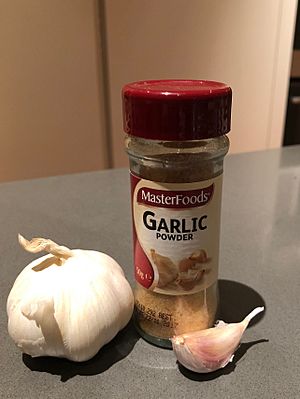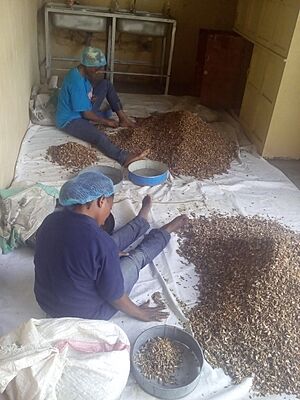Garlic powder facts for kids

Garlic powder and fresh garlic
|
|||||||
| Type | Powder | ||||||
|---|---|---|---|---|---|---|---|
| Course | Garnish | ||||||
| Place of origin | Central Asia | ||||||
| Region or state | Shandong, Henan, Jiangsu, Yunnan and Hebei | ||||||
| Associated national cuisine | Global | ||||||
| Cooking time | |||||||
| Serving temperature | Garnish or flavouring | ||||||
| Main ingredients | Garlic | ||||||
| Ingredients generally used | Sodium | ||||||
| 331 kcal (1386 kJ) | |||||||
|
|||||||
| Similar dishes | Garlic salt, Garlic flakes | ||||||
Garlic powder is a popular spice made from garlic that has been dried and turned into a powder. People use it to add a strong garlic flavor to their food. Making garlic powder involves drying fresh garlic and then grinding it into a fine powder. This can be done with big machines in factories or smaller tools at home. It's often found in spice mixes and seasoned salts.
Contents
How Garlic Powder is Made
Growing Garlic for Powder
There are two main types of garlic: Softneck and Hardneck. Hardneck garlic usually has a stronger, spicier flavor. It grows well in cold places. Softneck garlic grows better in warmer areas. It has a milder taste and a longer storage life. Softneck garlic is most often used to make garlic powder.
Garlic cloves grow best when planted in mid-autumn. They need a sunny spot to thrive. In warm places, garlic is planted in autumn and picked in early summer. In cooler areas, it's planted later in autumn and harvested in late summer. Large garlic bulbs are split into cloves. These cloves are planted about 4-6 inches apart and 3 inches deep. The pointy end of the clove should face upwards.
It's important to pick garlic at the right time. This stops it from rotting and helps the bulbs grow fully. If garlic is picked too early, it's called 'green garlic'. 'Soft' garlic means it's fully grown. If garlic looks damaged or caramelized inside, it was picked too late. You know garlic is ready to be harvested when its leaves turn yellow.
Making Garlic Powder in Factories
First, garlic cloves are peeled and sliced. Then, they are usually heated to a temperature between 150° and 160°C (about 300-320°F). This process removes most of the water. The goal is to get the garlic's moisture content down to about 6.5%. After drying, the garlic is sliced, chopped, or minced even more. This continues until it becomes the fine powder we use.
Making garlic powder on a large scale involves many steps. It starts from picking the garlic and goes all the way to packaging the powder. After harvesting, the raw garlic bulbs are cleaned. This removes their skin and separates the cloves. The garlic is then dried using different methods. Old ways include using the sun and wind to dry the garlic. Newer methods use special machines like vacuum dryers or freeze dryers. These technologies make the process faster and more efficient.
Once the garlic cloves are dry, they are turned into powder. This is done using large machines called milling machines. Milling breaks down the dried garlic into tiny particles. This process might involve several steps, from breaking up clumps to very fine grinding. These machines have parts like feeders, sifters, and dust collectors. Another important machine is the vacuum dehydrator. It removes all the moisture from the garlic. This helps keep its natural color, smell, and taste. Freeze drying is also a common method used in the garlic industry.
Where Garlic is Produced
There are about 300 different types of garlic grown around the world. Major areas for garlic production include North America, Europe, and Asia-Pacific. China grows the most garlic. Five main provinces in China grow garlic: Shandong, Henan, Jiangsu, Yunnan, and Hebei. These Chinese provinces are perfect for growing Softneck garlic. This is because Softneck varieties grow well in warmer places with mild winters.
The Garlic Powder Market
The market for garlic powder can be divided in many ways. This includes where it comes from, how it's packaged, what it's used for, and how it's sold. Some of the biggest companies that make and sell garlic powder are McCormick & Company, Garlico, Masterfoods, and Amazon.
China is the largest producer of garlic powder. India is the second largest. Both countries use a lot of garlic powder in their traditional foods. They also have many local suppliers.
How Garlic Powder is Used
A Brief History of Garlic
People aren't completely sure where garlic first came from. But it's thought to have started in Central Asia, South Asia, or southwestern Siberia. Garlic grows wild in Italy and Southern France. However, most of the world's garlic is grown in China. China produces about 20 million tonnes of garlic each year. That's about 80% of all garlic grown!
Garlic has been used for thousands of years. It has served many purposes, from medicine to cooking and even spiritual practices. Garlic has many healthy properties. These have made it useful for people in many different ways.
| Nutritional value per 100 g (3.5 oz) | |
|---|---|
| Energy | 1,390 kJ (330 kcal) |
|
72.7g
|
|
|
0.73g
|
|
|
Protein
|
16.6g
|
| Other constituents | Quantity |
| Water | 6.4 g |
| †Percentages estimated using US recommendations for adults. | |
Cooking with Garlic Powder
Garlic has been used in cooking in Asia for a very long time. It has been used for centuries as a whole food and to add flavor. Garlic can be changed in many ways to create products like powder, oil, and salt. These products add both nutrients and flavor to food. Garlic powder is often added to traditional dishes in Central Asia and European countries. It gives the flavor of garlic without the work of preparing fresh garlic. Plus, it lasts much longer!
Storing Garlic Powder
How long garlic powder stays good depends on how it's stored. Generally, it can last in good condition for up to 4 years. Packaged garlic powders usually have a 'best before' date. This date tells you how long the powder will be at its best for flavor and texture.
Garlic powder should be kept in a cool, dry place. This helps prevent it from clumping together. If the powder gets exposed to moisture or heat, it can harden or clump up. Fresh garlic can stay good for up to six months if it's a whole bulb. An unpeeled clove can last up to a month. But dehydrated garlic powder can last for years.
What's Inside Garlic Powder
Garlic powder is mostly carbohydrates (about 73%). This includes 9% dietary fiber. It also has about 17% protein, 1% fat, and 6% water. If you look at 100 grams of garlic powder, it provides 332 calories. It's also a great source of many important nutrients. For example, it has a lot of vitamin C (30% of your daily need), thiamin (31%), vitamin B6 (147%), and several dietary minerals.



